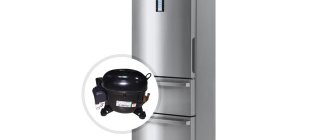Transporting in an incorrect position
The refrigerator is best transported vertically. On the side or back wall - as a last resort. The same applies to lifting and delivery to the floor. If he was brought in lying down, it’s the same as being brought in in that position.
The fact is that the refrigerator compressor is located at the bottom. There is a compressor small in its crankcase. When transported lying down or on its side, it ends up in the freon tubes. From there the oil flows into the evaporator or condenser. Although he shouldn't be there. Regarding transportation methods, we recommend reading the article about the correct transportation of the refrigerator in different positions.
Advice
If you have to transport or carry the refrigerator on its side, read the instructions. Manufacturers indicate on which side it should be transported - left or right.
Improperly carrying the refrigerator.
How to prepare a refrigerator for transportation
When purchasing a new refrigerator, special services from household appliance stores handle preparations for transportation and delivery.
Reference. When releasing equipment, the manufacturer immediately provides for the availability of reliable packaging for transportation of equipment.
If you plan to move, prepare the household appliance yourself . To do this, per day you need:
- Remove all food supplies from the cells.
- Turn off the device.
- Wait until the unit defrosts.
- Wipe interior and exterior surfaces with dishwashing detergent.
- Remove shelves and drawers and pack them in paper or fabric.
- Secure the compressor with shipping bolts and rope.
- Attach the power cord to the body with tape.
- Secure the door with tape.
- Wrap the refrigerator in a soft cloth, oilcloth, or film. This will protect the unit from scratches.
Ignoring the rules may result in the refrigerator not working properly in the future.
Interesting things on the site:
How to place a refrigerator in the kitchen
Is it possible to stack refrigerators on top of each other?
Is it possible to place refrigerators next to gas stoves?
Shaking during transportation
A lot of shaking during transportation is another reason why you can’t immediately turn on the refrigerator. Especially in summer, when the oil in the compressor becomes less viscous due to high temperature. During vibration, it can flow into the pipes leading to the evaporator or condenser.
The likelihood of this happening is low. But if you transport equipment along a country road, and even in the summer, when the oil heats up and becomes too liquid... That is why the refrigerator must be left to rest, even if it was transported according to the rules.
Correct operation of the refrigerator
- The first thing I want to say is that the refrigerator is such a thing that must operate at an ambient temperature of at least 10 degrees. This means that you cannot leave a working refrigerator on balconies or verandas or in any other place where the temperature during the cold period drops below the specified limit. Remember this! Let the Chukchi warm themselves in the refrigerator, but you and I won’t.
- Do not unplug the refrigerator for less than 1 minute. By performing such actions, you can cause the heart of the device - the compressor - to jam. Which will lead to the impossibility of further operation.
- You shouldn’t open the refrigerator doors once again just to look with a thoughtful look at “what to eat.” This is especially true for the freezer, which is generally not recommended to be opened more than once every few hours. By the way, you can try opening the freezer several times in a row. If the seal of the chamber is not broken, then it is unlikely that you will succeed, because due to the temperature difference, the door seems to be suctioned and it is very difficult to open it. If you apply force, you can easily damage the rubber seal located along the contour of the door. And this, as you yourself understand, will lead to the seal being broken and a lot of ice will form in the freezer very quickly.
- Just like when you first turned it on, you should not overload your refrigerator by adding a large volume of warm food to the freezer at once. Do this gradually in small batches.
- And the last thing I would like to say. Any refrigerator, even if it is equipped, needs periodic cleaning. At least once every six months it needs to be unplugged, defrosted and washed. And with refrigerators operating on the drip principle, this procedure will have to be done more often. It is better to carry out this action as needed, focusing on the amount of “snow” in the freezer. In summer you will have to do this more often, in winter less often.
That's all. Proper operation of the refrigerator will allow you to enjoy trouble-free operation of your appliance for many years - an indispensable assistant for preserving food.
Good luck with your exploitation!
Turning on a new refrigerator for the first time is an important moment on which its further service life depends. Unfortunately, not all buyers attach importance to this. Such illiteracy leads to malfunction of the device and its breakdown.
Of course, it would be wrong to blame everything on the incorrect first switching on. After all, besides this, there are a number of other reasons. But still, the main reason why the refrigerator failed is precisely the neglect of the rules for first plugging into the network. In order for the new equipment to serve faithfully for many years, you must follow the instructions in the instructions after purchase. In fact, there are few of them, and there is nothing complicated about them.
What can happen
What happens if you turn on the refrigerator immediately after transportation? There are several possible consequences, namely:
- The refrigerator will not cool well for several hours to several days;
- The compressor will work with increased load until it moves the oil through the system;
- The refrigerator will not turn on due to the compressor being turned off by the security system;
- The compressor may jam due to lack of oil in it;
- The compressor may burn out due to increased load (especially in winter);
- The oil may decompose due to the high temperature in the compressor.
In any case, it is better to wait a while and not take risks. If the refrigerator does not cool well at first, it’s not so bad. But if the compressor seizes, repairing it will be expensive. In some cases it will cost up to 30% of the price of the refrigerator
Installation
Before releasing the movers and installing the refrigerator, check the package contents, re-read the warranty card and check the functionality. Only after making sure that all components are available, that the warranty is filled out correctly and that the equipment is in good working order, let the store representatives go. If something goes wrong, make a claim on the spot and in fact, otherwise it will be difficult to prove something later.
Installation requirements:
- The room humidity should be no higher than 80%. If you have nothing to measure humidity with, pay attention to the walls, floor and ceiling of the kitchen - if you notice condensation, the humidity is too high.
- Provide adequate ventilation. If you find problems, contact the Housing Office to clean the ventilation ducts.
- Choose the coolest place in the kitchen.
Pay attention to the climate class indicated on the information sticker. Read more about climate classes and the conditions for installing a refrigerator in accordance with them in a separate publication.
Are you planning to install 2 refrigerators at once or place a freezer next to each other? Do not place them close to each other - ensure a distance of at least 2 cm.
Also follow the rules for connecting to the electrical network:
- Correlate the equipment parameters with the electrical network parameters. If it operates with a voltage of 220 V, connect to a two-phase power supply, 380 V to a three-phase power supply.
- Connect to a grounded outlet to ensure safe operation. It wouldn’t hurt to install a circuit breaker to protect equipment from power surges.
- Do not use extension cords, carriers or adapters - connection is only permissible into a fixed outlet in the wall.
After how many hours do you turn on the refrigerator?
There is no exact recommendation for how long you can turn on the refrigerator after transportation or delivery. It depends on the time of year and the position in which the refrigerator was transported.
When transporting lying down, the power of the refrigerator plays a role. The larger it is, the greater the volume of oil in the compressor. Accordingly, more of it will leak into the condenser or evaporator. After this, it will take more time for it to flow into the compressor.
Here we provide general recommendations. For example, a low-power refrigerator needs to stand for 2 hours. And high power – 3 hours. Nothing bad will happen if a low-power refrigerator sits for an hour longer.
In summer
- When transported in an upright position, you can turn on the refrigerator after 4 hours;
- When transporting in an inclined or horizontal position, you need to wait 16 hours.
Spring and autumn
- If the refrigerator was transported vertically, you can turn it on after 5 hours;
- If transported in a supine position, turn on the refrigerator after 16 hours;
in winter
- When transporting vertically, turn on the refrigerator after 6 hours;
- When transporting horizontally, turn it on after 16 hours.
How to pack?
To transport the refrigerator lying down correctly and safely, you will need:
- original packaging (if preserved) or bubble wrap packaging - it can be purchased at a hypermarket;
- packaging of masking tape - it is convenient to tear it off by hand, which saves time;
- scissors - cut off the film;
- newspapers - usually there are a lot of them and are placed in mailboxes for free as advertising;
- factory transport spacers to secure the compressor or screws;
- paper towels or moisture-absorbing wipes;
- pieces of cardboard, rags or old blankets.
Without packaging you will not transport the refrigerator correctly!
Your actions, including if you are transporting the refrigerator horizontally:
One day before:
You need to carefully and carefully pack your unit to reduce the risk of damage:
- Find the instructions for your refrigerator and look at the rear circuit layout diagram.
- Determine the discharge tube with the device running. Do this manually or check the instructions.
- Prepare factory packaging or packaging materials
- Unplug the refrigerator and remove the food.
- Defrost the device, drain the water, and wash the shelves. To save time, use paper towels or napkins to absorb moisture. After wiping, still dry it open.
- Take out everything that can be removed - containers, grilles, shelves, doors, glass. Wrap the glass with bubble wrap. Doors that could not be removed, for example from a freezer, should be secured with tape. Nothing should open or move inside the refrigerator.
- Secure the position of the compressor with factory-installed transport spacers or screws. If they are not there, crumple up sheets of newspaper and position them so that the compressor and other moving parts of the circuit are immobilized. Secure the position with tape, if necessary, wrap it around the refrigerator.
- Wrap the entire refrigerator in several layers of bubble wrap and secure it with tape.
It’s great if the original packaging has been preserved - the preserved properties of polystyrene foam are difficult to achieve from other materials. In addition, in modern models it indicates the side on which the device can be placed.
Tip: if you can’t get bubble wrap, wrap the refrigerator in several layers of textiles, a layer of cardboard, and then secure it with adhesive tape. This measure will prevent scratches and chipping of the coating on the surface of the device.
If you are buying a used refrigerator, ask for the model and look at the instructions. Ask if the refrigerator has been cleaned and ask to fix the compressor. You should understand that refrigerators are usually sold second-hand for pick-up, so as soon as you give the money, the former owner will not care how you transport your refrigerator - even with the freezer down the stairs. And you won’t be able to complain about its performance: the refrigerator could have been fully functional before transportation, which resulted in its malfunction.
On the day of transportation:
The removal of the refrigerator from the entrance must be carried out on the correct side, and the side along which the discharge tube passes must be the top. When moving down stairs, the compressor should be at the bottom while maintaining a generally horizontal position.
The same conditions must be met when bringing the refrigerator into the entrance in order to maintain its working condition.
How to transport it in a car?
Ideally, the rented gazelle is equipped with clamps and stops, and the height of the side allows you to transport the refrigerator vertically. When transporting horizontally, the refrigerator will still have to be secured . If you are transporting it along with other things, place bales of textiles on the sides of the device or prop it up with upholstered furniture.
When transporting a short distance of a couple of blocks at low speed (40-60 km/h) on a flat road, the refrigerator does not need to be fixed: it has a large mass and is therefore inert. In all other cases - when transporting over significant distances with unpredictable road terrain and traffic congestion - find a way to do it.
Before transportation, place several layers of cardboard or soft foam material, such as isolon, on the bottom of the body.
Tips for transportation and inclusion
When you need to transport a refrigerator lying down, your warranty may be voided. Therefore, check with the sellers whether it can be transported on its side. If a warranty claim occurs, always say that you transported and brought in the refrigerator vertically.
If you order delivery from the same place where you bought the refrigerator, check the shipping method. Many people transport equipment in a lying position for convenience. But they will tell you that the refrigerator was in the back of the car. It is best to control this process.
Proper transportation of the refrigerator.
Immediately install the refrigerator in the place where it should be. Do not plug it into the network under any circumstances! In 95% of cases, it will start working immediately after switching on. This cannot be allowed. Wait the required time and only then plug the plug into the outlet.
If after 2 days of operation the refrigerator does not cool well, this is a warranty case. Study the instructions for the warranty and its conditions. Be sure to check shipping requirements, etc. Only after this, contact the service center or return the equipment.
Many manufacturers are playing it safe. The instructions may say that the refrigerator can only be transported while standing. Or that it should stand for 48 hours after installation. In reality this is not the case. Such requirements are prescribed in order to deny a warranty.
Turning on the refrigerator after defrosting/moving
The requirements for delivering a refrigerator from a store to an apartment also apply when moving to a new place of residence. This applies to both new and old devices. When purchasing a used unit, it is also not connected to the network for the required time.
After complete defrosting, the device is not plugged in for two hours. During this time, condensate evaporates. It is spent on washing the device and drying the removable compartments.
Natural defrosting
Important! Defrosting should occur naturally. Do not use a hair dryer or place a container of hot water inside. It takes at least 4 hours for the walls of the appliance and the freezer to be completely free of ice.
Useful tips
To avoid any difficulties during transportation, it is necessary to take into account the advice of professionals. They will help prevent breakdowns of the refrigeration system and eliminate all problems that arise.
Helpful Tips:
- When purchasing equipment, you need to carefully study the nuances of its delivery. Otherwise, any damage (due to the fault of the seller) may lead to additional financial losses on the part of the buyer.
- After delivery, the refrigerator must be left to rest before connecting to the network. The expected duration of this process must be clarified with the seller or delivery provider.
- The longer you let the equipment sit after transportation, the less likely it is to quickly fail.
- During settling, all doors of the device must be opened.
- When transporting in the cold season, you can find condensation on various parts. After delivery, it must be wiped with a dry cloth to prevent drops of liquid from getting into the engine.
- The electric motor of the device is most susceptible to damage. Therefore, it is necessary to protect it as much as possible during transportation.
- The first switching on of the refrigerator should be a test. If you immediately load the shelves with products, the device will function at maximum, which will lead to various problems.
- Do not place food tightly against the walls in the freezer compartment. If you ignore this advice, the air circulation will deteriorate and the equipment will work for a minimum amount of time.
- During delivery, the refrigeration unit housing may become dirty. To wash it from settled dust and dirt, you need to use a sponge soaked in a soap solution. It is prohibited to use water or any household chemicals. The first can get into the parts of the unit and damage it, and the second can negatively affect the loaded products.
The refrigerator must be turned on after transportation, taking into account all the prescribed rules. If you do not pay attention to them, the unit can quickly fail. If you follow the nuances of transportation and correct connection, the device will perform its functions efficiently for a long period.
Installing correctly
This moment is quite important, since if installed incorrectly, the operation of the unit will be difficult, more electricity may be consumed, as a result of which the refrigerator will fail faster. Here are a few points to pay attention to:
- Firstly, the plane of the surface on which the refrigerator will stand must be flat.
- Secondly, you need to adjust its legs so that it stands level and does not wobble.
- Thirdly, you can install the device in any convenient place, but preferably not very close to heating objects (battery, gas stove).
Although the instructions always require a level position of the refrigeration appliance on the floor surface, it is better to install it with a slight slope back. In this case, you do not need to make any special efforts to close the door; it will close itself.











